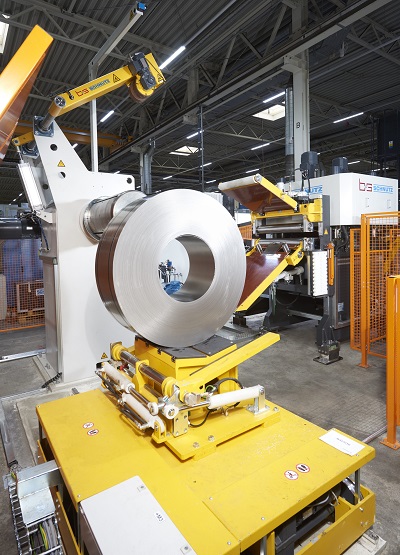
In the automotive industry, lightweight construction is more in demand than ever before. However, car seats and their fastening elements must withstand the enormous forces exerted on vehicles involved in accidents. High-strength materials are used to ensure high resilience, also with a lower weight. According to recent studies the proportion of high-strength steels used in vehicles will increase from 15 per cent in 2017 to nearly 40 per cent in 2030. The machines of numerous automotive suppliers used up to now are often not designed for processing these materials. The globally active automotive supplier Adient has therefore taken appropriate upgrade measures: The press lines at the Solingen works were extended by the addition of three highly efficient strip feeding lines with high-performance machines from Schnutz GmbH. The new machines enable perfect feeding and easy processing of the special materials with perfect flatness being achieved.
"Prior to awarding the contracts to Schnutz, Adient carried out extensive tests at various suppliers. The aim was to ascertain whether the machines were suitable for the complex and multistage forming processes of high-strength steel," says Dr.-Ing. Lutz-Stefan Henrich, Managing Director of Schnutz GmbH. "As we have many years of expertise in the levelling of demanding materials such as high-strength steels and aluminium, we received a related enquiry." In the technical centre in Siegen/Germany, Schnutz convinced the automotive supplier of the quality of its machines in joint levelling tests. For this reason, Adient decided to extend its machinery for processing high-strength materials by the addition of three strip feeding lines including a high-performance leveller from Schnutz.
Advance analysis allows individual adaptation
In the pressing plant of Adient in Solingen, seat rails are manufactured on several lines. "The high-strength material used requires special treatment in order to obtain the required flatness with optimal residual stress in the strip material," says Henrich. "Only when the geometry of the leveller matches the particular product can the best results be achieved." That is why Schnutz uses simulation programs to analyse the working processes and plastic forming behaviour of the materials used in order to modify the machines to suit customer-specific requirements. The experts of Schnutz used the results of these levelling tests to adapt decisive design parameters such as the number and diameter of the levelling rolls to the customer's material.
"For fastening elements in the automotive industry, high resilience is an important factor despite the low weight," says Henrich. "For this reason, the seat rails are made from high-strength steel materials. High plastic deformability of the steel materials used must be ensured at the same time." The steel forming resistance associated with increasing yield strengths places particularly high demands on the machinery used.
Optimal flatness and elimination of the dish-shape
Each of the new machines is a leveller with integrated feed unit, coil lift truck, decoiler, loop equipment and appropriate automation including safety devices. "The coils are pushed on to the decoiler by the coil lift truck," explains Henrich with regard to the process. "For this purpose, they are automatically placed on one level with the decoiler mandrel. When the coil has been clamped in place, it is rotated, so that after loosening the binding strap, the beginning of the strip rests on the table." After opening the binding strap, the strip is fed by a feed unit through the leveller and via the transfer table to the servo feed of the press.
A particular challenge when levelling high-strength steels is the so-called dish-shape – a curvature transverse to the direction of strip travel. If this is not eliminated, further processing in a press can be hindered to a large extent or even prevented. "It is therefore important that not only the coil curvature as such is corrected, but also an optimal flatness exists in the traverse direction of strip travel," explains Henrich. "This is achieved by the special design of Schnutz levellers." In this way, the new machines ensure that the materials, also after further forming, maintain the specified shape and position tolerances. Adient was particularly happy that the dish-shape could be effectively eliminated also with high material strengths.
Efficient and reliable machine operation since spring 2018
Adient was also very satisfied with the high level of automation of the machines. "We naturally also ensured that the necessary safety measures were in place," says Henrich. "Particular attention was paid to the loading of the decoiler and the interface to the coil lift truck." Since the beginning of 2018, the machinery at the Adient works in Solingen has been gradually extended by the addition of strip feeding lines including high-performance levellers. The first machine was implemented in January and the second in April, whilst the third machine followed in the second half of the year as planned. "As a result, the output of the extended machinery could almost be doubled, whilst maintaining the highest quality at the same time," says Henrich. "This has ensured that Adient at their site in Solingen is well equipped to meet future challenges."
Further information is available online at: www.b-s-germany.de, www.schnutz.com, www.adient.com
Kobe 13 A.D. Shoes














